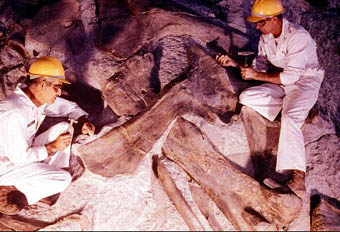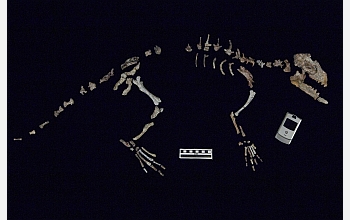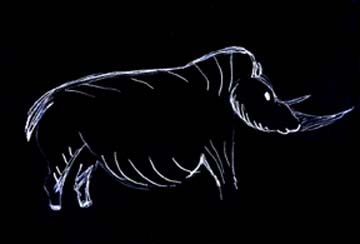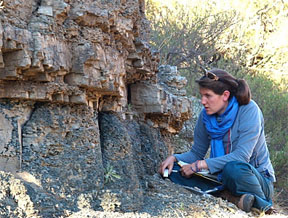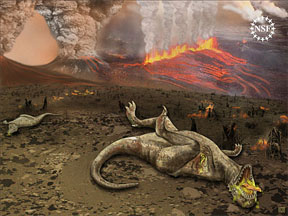An Overview of Earth History
The Earth has been around for approximately four and a half billion years! The geologic time scale is the timeline that describes all this time.
Scientists have found rocks that formed during every time period of Earth's history! In sedimentary rocks, they have found millions of fossils and clues to past environment. Take a look at the stories below to discover how some scientists are discovering more about our planet's past.
Missing Link Between Whales and Four-Footed Ancestors Discovered
Did Life First Form in a Mica Sandwich at the Bottom of an Ancient Sea?
Using Leaves From the Past to Tell the Future!
Digging Woolly Rhinos
Did T-Rex Have a Plant-Eating Relative?
Diamonds are Ancient History
Geologic Findings Undermine Theories of Permian Mass Extinction Timing
Old Rocks Give New Clues about Ancient Earth
Evolution Hits the Beach - streaming RealVideo (1 min. 7 sec.) from NSF
The History of the Universe in 60 Seconds or Less - Dr. Eric Schulman - streaming RealVideo (1 min. 16 sec.) from NSF
The table below provides a brief overview of Earth history. M stands for millions of years. The present time is at the top of the table and ancient time is at the bottom of the table.
| Where the continents were | Eras | Approximate age (in years) | Subdivision | Approximate duration (in years) | Notes |

Earth, 20 M ago |
CENOZOIC | 10,000 2 M 5 M 24 M 37 M 57 M 66 M |
HOLOCENE PLEISTOCENE PLIOCENE MIOCENE OLIGOCENE EOCENE PALEOCENE |
3 M 19 M 13 M 20 M 9 M |
The beginning of the Eocene was a period when the Earth was very hot, with palm trees and alligators at the north pole. Earth but cooled by the start of the Quaternary. This period relates to today's concern about global warming. Homo sapiens evolved and Ice Ages occures towards the end of this time. The Little Ice Age (which is not a true ice age) occured a few hundred years ago. |

Earth, 190 M ago |
MESOZOIC | 144 M 208 M 245 M |
CRETACEOUS JURASSIC TRIASSIC |
78 M 64 M 37 M |
The Mesozoic is the period in which the dinosaurs lived, and its end was marked by the K-T extinction. This extinction event dramatically changed the Earth's flora and fauna, and its causes are still being investigated by scientists around the world. During the Mesozoic, the giant continent Pangaea broke apart into the continents we have today. |

Earth, 400 M ago |
PALEOZOIC | 286 M 360 M 408 M 438 M 505 M 570 M |
PERMIAN CARBONIFEROUS DEVONIAN SILURIAN ORDOVICIAN CAMBRIAN |
41 M 74 M 48 M 30 M 67 M 65 M |
The Cambrian period, at the beginning of the Paleozoic, was the first time that multicellular life forms florished on Earth. By the end of the Paleozoic, and beginning of the Mesozoic, all the continents of the Earth came together to form the giant continent called PANGAEA and dinosaurs began to roam on land. |

Earth, 540 M ago (end of Precambrian) |
PRECAMBRIAN | 2800 M 4800 M |
PROTEROZOIC ARCHEAN |
2300 M 2000 M |
This period is about 5 times as long as the Paleozoic and Mesozoic combined, a very long time. Less is known about it than the younger time periods. The oldest fossils are of bacteria/archaea dating from 3000 M. The oldest rock is dated at 3800 M. The Earth is thought to be 4600 M years old. |
 The Mystery of Mass Extinction is No Longer Murky
The Mystery of Mass Extinction is No Longer Murky
 Fossil Record Suggests Insect Assaults Foliage May Increase with Warming Globe
Fossil Record Suggests Insect Assaults Foliage May Increase with Warming Globe
 Giant Fossil Frog Found in Madagascar
Giant Fossil Frog Found in Madagascar
 "Frogantuan" - A Podcast about Giant Fossil Frogs
"Frogantuan" - A Podcast about Giant Fossil Frogs





